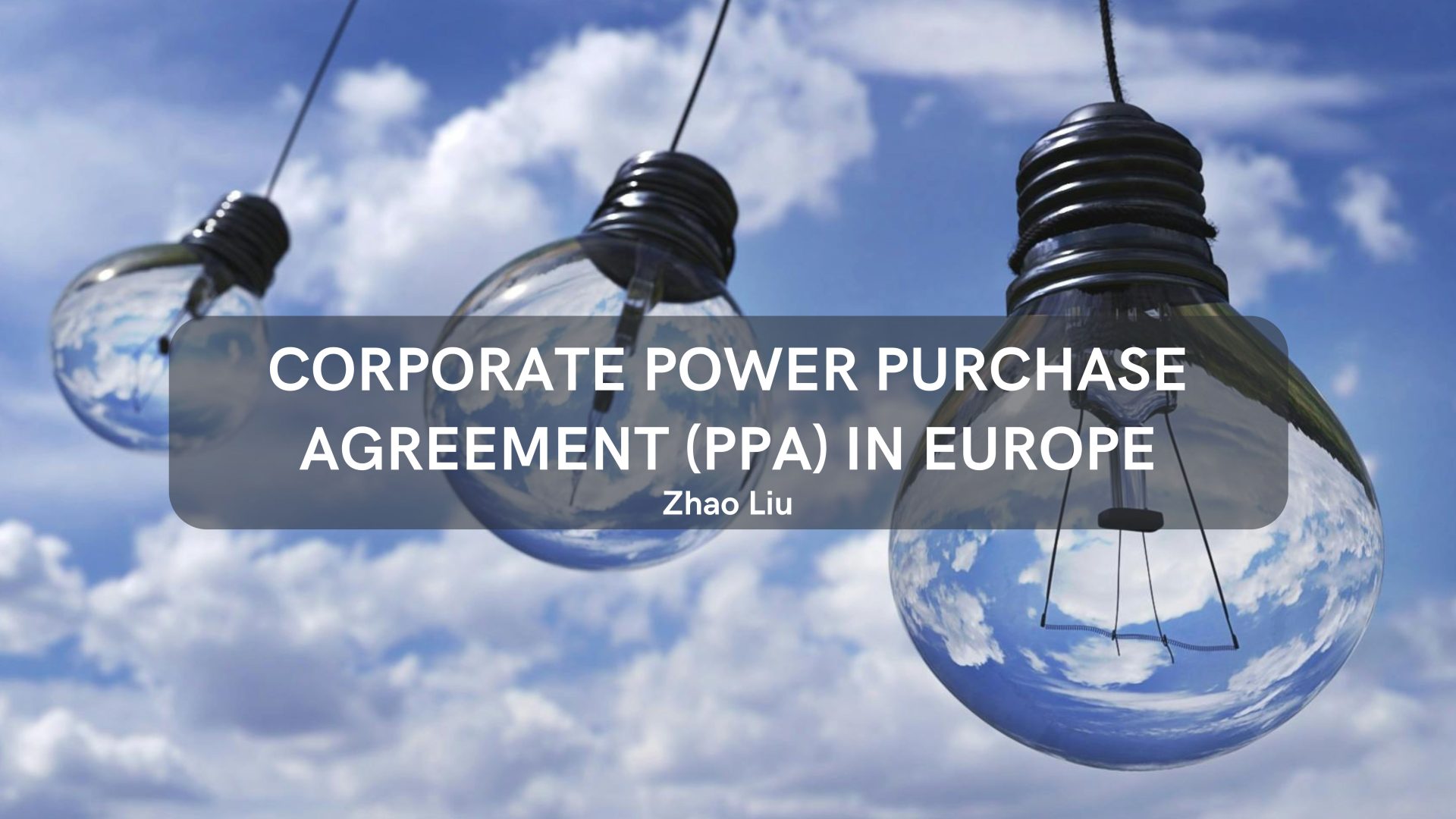Article de Zhao Liu (MS EnvIM 2023-24)
Introduction
As of January 2024, the annual green power consumption of Fortune 500 Partners totals nearly 70 billion kilowatt-hours (US EPA, 2024), which is equivalent to 15% of France’s total electricity consumption in 2023 (Réseau de Transport d’Électricité, 2024). Some leading companies like Google have achieved 100% green power usage. Achieving such high levels of renewable energy consumption is challenging for these large companies due to the significantly rising electricity demand and relatively limited supply of green energy. Many companies utilize Power Purchase Agreements (PPAs) to facilitate their transition.
What is the Power Purchase Agreement (PPA) ?
The power system consists of three component : power generation, transmission, and distribution, and involve various stakeholders and complex legal frameworks. (The World Bank et al., 2023). Traditionally, electricity suppliers sign with generators. However, large companies purchasing substantial amounts of power from electricity suppliers face risks of cost instability and unpredictability.
Over the past decade, many companies have begun signing PPAs with electricity generators, rather than electricity suppliers. These agreements, known as corporate PPAs, are over-the-counter deals between corporate buyers and power generators. Other types of PPAs include utility PPAs, where a utility agrees to purchase electricity from a producer, and merchant PPAs, involving contracts between a producer and an intermediary. Although a PPA can technically pertain to contracts for any type of energy, it typically refers to those involving the purchase of renewable energy in recent years.
Corporate PPAs bring significant benefits to both producers and companies. They reduce the uncertainty primarily associated with electricity price fluctuations for companies transitioning their electricity demands from fossil fuels to renewable sources. For renewable energy developers, long-term PPAs, typically exceeding ten years at fixed prices, enhance the ability to secure funding.
Figure 1: Corporate Renewable PPA Capacity in Europe by Power Purchase Company
|
Company |
Total Contracted Capacity (MW) |
Company |
Total Contracted Capacity (MW) |
| Amazon | 5,288 MW | Orange | 405 MW |
| 2,785 MW | Mercedes Benz | 351 MW | |
| Alcoa | 1,891 MW | Renault | 350 MW |
| Microsoft | 1,766 MW | Umicore | 338 MW |
| Norsk Hydro | 1,486 MW | Air Liquide | 315 MW |
| Meta (Facebook) | 959 MW | Borealis | 307 MW |
| Equinix | 668 MW | Deutsche Bahn | 286 MW |
| LyondellBasell | 643 MW | BT Group | 282 MW |
| Netherlands Railways | 572 MW | Novartis | 277 MW |
| Mytilineos | 549 MW | Undisclosed buyer | 276 MW |
| Vodafone | 548 MW | Arla Foods | 276 MW |
| BASF | 501 MW | Unspecified | 268 MW |
| SNCF Energie | 422 MW |
Source: WindEurope.org
Corporate PPA in Europe
The new Renewable Energy Directive in 2023 raises the EU’s binding renewable energy target for 2030 to a minimum of 42.5%, with an aim for 45%. Along this process, renewable PPAs are an important driver for investments in new renewable energy installations in Europe and the achievement of the EU’s climate-neutrality target.
When PPAs appeared in Europe at the beginning of the 2010s, they were expected to become a major driver for more market-based renewables deployment. However, the adoption of this concept has been slower than expected (European Commission, 2024). Several reasons account for this : initially, policies were not confirmed and supportive in the first half of the 2010s. This uncertainty began to change with the signing of the Paris Agreement in 2016 and gradually faded with the policy implementation of Clean energy for all Europeans package and other related policies.
In 2023, the European PPA market experienced substantial growth, achieving a new peak with 16.2 GW in disclosed contracted volumes, representing a surge of over 40% compared to 2022, with a 37% compound annual growth rate from 2018-2023. The transaction count reached a record-setting 272 deals, a 65% increase compared to 2022, with a 52% compound annual growth rate from 2018-2023 (Pexapark, 2024). Spain led in capacity with 4.6 GW and 46 contracts, followed by Germany with 3.7 GW and 41 deals. Italy, the UK, and Greece followed with capacities of 1 GW, 0.96 GW, and 0.95 GW, respectively. In terms of corporate PPAs, according to WindEurope’s Corporate PPA tool, Spain also leads, followed by Germany.
Figure 2: Corporate Renewable PPA Capacity in Europe by County

Challenges of Corporate PPA
Despite the promising potential and outlook that corporate PPAs offer to companies and renewable energy developers, numerous challenges persist. These challenges include significant price risks, credit risks, and legal and regulatory uncertainty. Addressing these issues is crucial to ensure the continued growth and effectiveness of the PPA market.
- Price Risks: PPAs are primarily driven by the need to hedge against energy price volatility, leading many corporations to sign agreements at prices above market value for long-term price stability, similar to (RE-Source, 2023). However, rapid growth in renewable energy technologies and markets still presents significant price risks for PPA participants.
- Credit Risks: Renewable power projects are typically financed on an equity basis, with the PPA seller repaying debt from long-term cash flow from the electricity buyer. The credit risk of a PPA arises from the possibility of either party failing to meet their financial obligations. Therefore, a bankable PPA structure is essential to ensure the creditworthiness of both parties.
- Policy Risks: Major policy risks for renewable energy and PPA development include regulatory changes, shifts in government energy policies, legal and contractual changes, and modifications in grid access. And Policy risks have become increasingly evident following the European energy crisis.
European Union’s Solution to Corporate PPA Challenges
- To mitigate the price risks, it is recommended to use electricity futures market data for fair pricing, distinguish between short-term and long-term market liquidity, consider the Market Price of Risk (MPR), and establish reliable benchmarks through regular price polling (Trabesinger, 2023).
- To address credit risks, the EU Reform requires Member States to provide market-based guarantees to mitigate the financial risks of buyer payment defaults, ensuring that energy producers are not left without a source of revenue (PWC, 2023). A subsequent section will introduce a case study of the Corporate PPA Guarantee Fund in France.
- In terms of legal and regulatory uncertainty, despite the lower currency and legal risks associated with PPA transactions within the EU, many specific legal provisions, particularly those regarding dispute resolution, remain unclear. Therefore, more comprehensive guidance and regulations are needed within the EU. Additionally, the legal issues surrounding PPA transactions outside the EU are critical, given that many PPA purchasers within the EU are non-EU entities, such as Google.
Specifically, in May 2022, the EU published guidance on PPAs, aiming to speed up permit-granting procedures for renewable energy projects and facilitate PPA progress among Member States (European Commission, 2022). The reformed electricity market design empowers Member States to assist more corporate energy buyers in signing corporate PPAs. Member States must ensure the availability of market-based guarantees for PPAs. This initiative will enhance the competitiveness of the EU industry by reducing its exposure to the volatile prices of fossil fuels.
In May 2024, the European Council signed off on updated electricity reform rules, promoting customer and investor uptake and reducing unnecessary red tape and charges. Member States may further support investment in renewables under PPAs by setting up guarantee schemes and removing barriers preventing the expansion of PPA markets, including cross-border PPAs (European Council, 2024). EU member states will have up to six months to adapt their national legislation to the provisions of the electricity market directive.
Case study : France’s Corporate PPA Guarantee Fund
France’s goal of carbon neutrality by 2050 is accelerating the adoption of renewable energy. This transition boosts national competitiveness, with PPAs playing a key role in stabilizing long-term energy costs for industries and developers.
The start of corporate PPAs in France was relatively late. The first corporate PPA was signed in May 2019 (Bellini, 2019). This delay is mainly because France’s energy mix was already quite decarbonized due to its large nuclear production, making PPAs less appealing. Additionally, the difficulty in selling Guarantees of Origin to potential buyers was another obstacle (E-Cube, 2022).
Figure 3: Corporate PPA Contracted Capacity and Deal Amount in France

Source: WindEurope.org
The French government has implemented several mechanisms to support renewable energy development and PPA application. However, the development of PPAs faced bottlenecks due to the uncertainty of long-term contracts. To address this, the French government introduced a guarantee fund in November 2022 to encourage long-term renewable energy PPA signings. Managed by Bpifrance, it initially supports contracts up to 500 MW, equivalent to the consumption of a city like Bordeaux, and may expand further (Le ministère de l’Écologie, 2022). In October 2023, the first guarantee contract under this fund was signed, guaranteeing 80% of the industrial buyer’s default risk and securing a minimum of 10 GWh of renewable electricity annually, providing up to 25 years of cost stability (Ministère de l’Économie et des Finances, 2023).
Conclusion
The EU aims to achieve a minimum of 42.5% renewable energy by 2030. The industry seeks to expedite its path to net zero using affordable, clean electricity. The European Commission’s Electricity Market Design (EMD) proposal and the European Parliament’s work recognize PPAs as essential for supporting Europe’s energy transition (WindEurope, 2023). However, the European energy crisis has introduced new challenges for the PPA market. To ensure continued growth and unlock greater levels of green energy, Europe must remove the remaining barriers and further stimulate PPA deals. This includes responding to corporate energy buyers’ calls for more renewables, ensuring reliable grid access, and expediting permitting for new wind and solar farms. Additionally, providing legislative support, managing price risks, ensuring bankability, and educating procurement staff to demystify PPAs are essential steps.
References
Bellini, E. (2019). Le premier « Corporate PPA » pour le solaire a été signé en France. https://www.pv-magazine.fr/2019/05/23/le-premier-corporate-ppa-pour-le-solaire-a-ete-signe-en-france/
E-Cube. (2022). Analyse des dynamiques et des mécanismes publics de soutien aux énergies renouvelables favorables aux PPA en Europe. https://www.cre.fr/fileadmin/Documents/Actualites/import/220204-E-CUBE-CRE_PPA.pdf
European Commission. (2022). COMMISSION RECOMMENDATION on speeding up permit-granting procedures for renewable energy projects and facilitating Power Purchase Agreements. https://eur-lex.europa.eu/legal-content/EN/TXT/?uri=PI_COM%3AC%282022%293219&qid=1653033569832
European Commission. (2024). Enabling framework for renewables. https://energy.ec.europa.eu/topics/renewable-energy/enabling-framework-renewables_en#power-purchase-agreements
European Council. (2024). Electricity market reform: Council signs off on updated rules. https://www.consilium.europa.eu/en/press/press-releases/2024/05/21/electricity-market-reform-council-signs-off-on-updated-rules/
Le ministère de l’Écologie. (2022). Mise en oeuvre d’un fonds garantissant les contrats d’approvisionnement de long terme pour des industriels lorsqu’ils sont adossés à des installations renouvelables. https://www.ecologie.gouv.fr/presse/mise-oeuvre-dun-fonds-garantissant-contrats-dapprovisionnement-long-terme-industriels
Ministère de l’Économie et des Finances. (2023). 12/10/2023 – Signature du 1er contrat de garantie relatif à l’approvisionnement en électricité de long terme pour des industriels lorsqu’ils sont adossés à des installations renouvelables. https://presse.economie.gouv.fr/12102023-signature-du-1er-contrat-de-garantie-relatif-a-lapprovisionnement-en-electricite-de-long-terme-pour-des-industriels-lorsquils-sont-adosses-a-des-installations-renouvelables/
Pexapark. (2024). European PPA Market Outlook 2004. https://go.pexapark.com/l/891233/2024-02-06/hd4y8/891233/1707212342jlEFslZb/European_PPA_Market_Outlook_2024_HighR.pdf
PWC. (2023). Power Purchase Agreements and Contracts for Differences: unraveling the complexity. https://news.pwc.be/power-purchase-agreements-and-contracts-for-differences-unraveling-the-complexity/
RE-Source. (2023). The difference between pricing and valuing a corporate PPA. https://resource-platform.eu/news/the-difference-between-pricing-and-valuing-a-corporate-ppa/
Réseau de Transport d’Electricité. (2024). Bilan électrique 2023. https://assets.rte-france.com/prod/public/2024-02/Bilan-electrique-2023-synthese.pdf
The World Bank et al. (2023). Understanding power purchase agreements. https://ppp.worldbank.org/public-private-partnership/sites/ppp.worldbank.org/files/documents/Africa_Understanding_Power_Purchase_Agreements.pdf
Trabesinger, W. (2023). PPAs, Benchmarking and the Price of Risk. https://www.linkedin.com/pulse/ppas-benchmarking-price-risk-werner-trabesinger/
US EPA. (2024, Jan 23, 2024). Green Power Partnership Fortune 500® Partners List. https://www.epa.gov/greenpower/green-power-partnership-fortune-500r-partners-list
WindEurope. (2023). RE-Source 2023 marks 7.8 GW PPA record but industry urges for barriers to be removed to reach EU net zero objectives. https://windeurope.org/newsroom/press-releases/re-source-2023-marks-7-8-gw-ppa-record-but-industry-urges-for-barriers-to-be-removed-to-reach-eu-net-zero-objectives/

